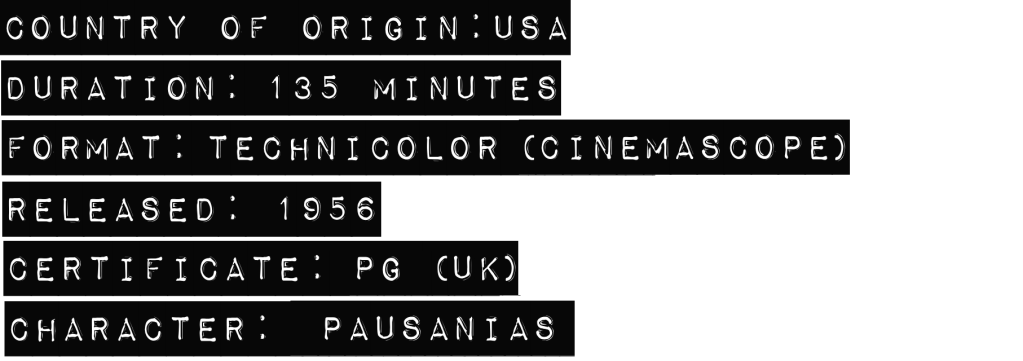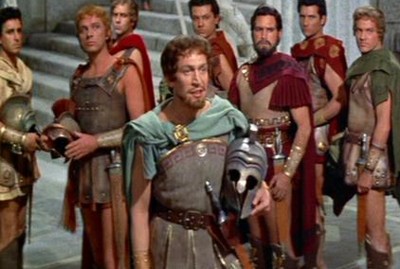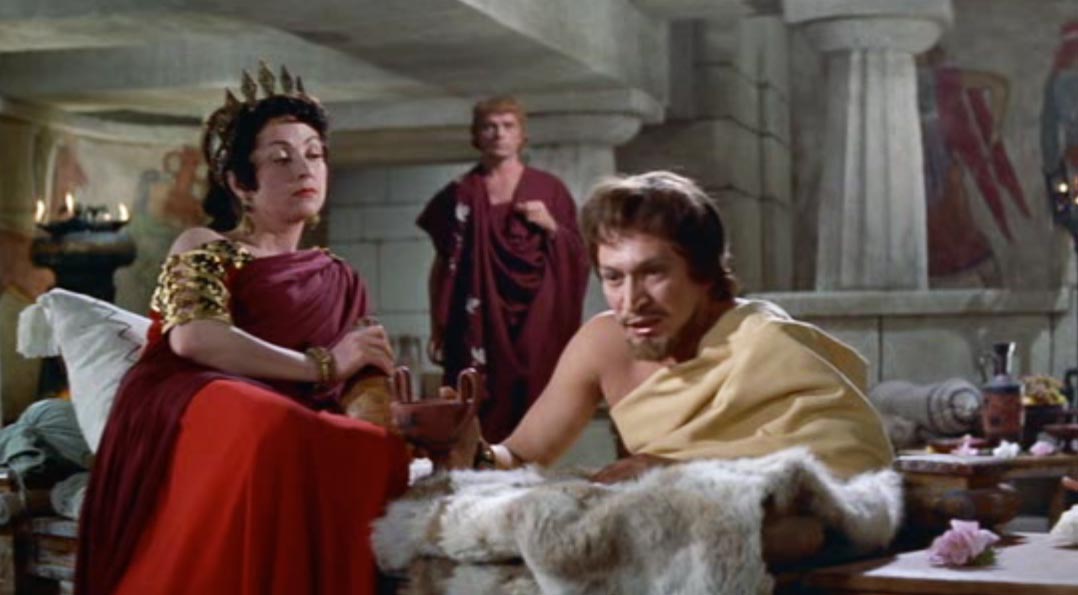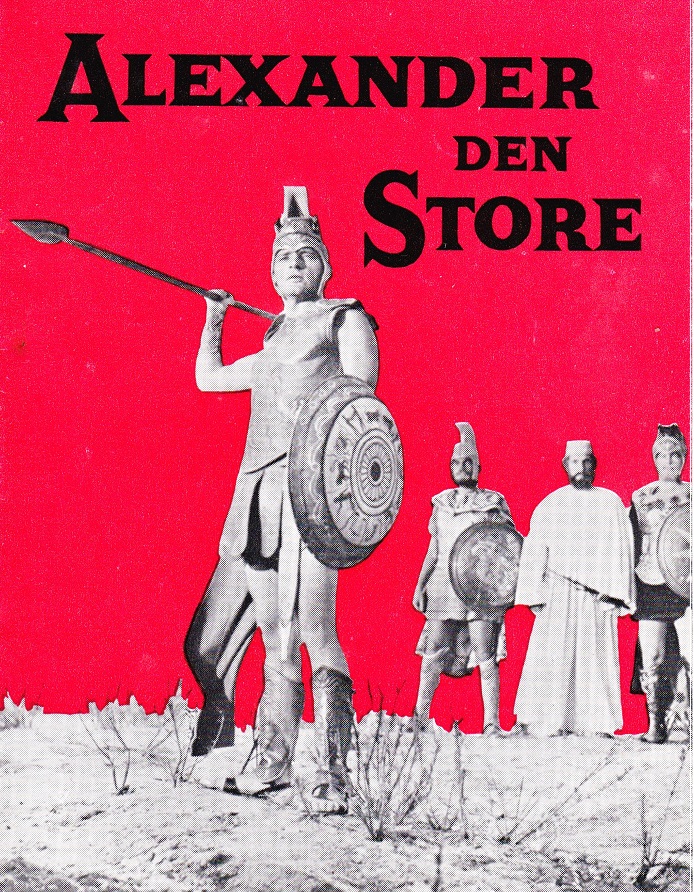
The danger in making a spectacle is that the widescreen format and the cast of thousands often submerge the central theme and its characters in glittering trivialities. So many of the spate of spectacles in the mid-to-late Fifties suffered in that way. Writer, director and producer, Robert Rossen, however, succumbed to another danger. So passionate was his admiration for Alexander; so sincere was his interpretation of the Warrior’s life and times, that the rambling narrative lost its dramatic momentum and the final result was to instruct rather than entertain.
The greatness of this film is that it represents one man’s conception of Alexander, a conception based on two years study of the documented evidence from both classical and contemporary writers. Rossen saw Alexander as something more than the world’s first great militarist – he drew him as a man convinced that his destiny was to be a god.

Most people may not be aware of it, but Peter – a relative unknown in 1956, was chosen to play the lead role after Rossen saw him play Dunois in ‘St Joan’ at the Art’s Theatre’ in London. Although he was excited about the opportunity of appearing in a major Hollywood blockbuster Siobhan McKenna, his co-star in play wasn’t quite so enthusiastic.
In a private letter to Peter, she expressed her misgivings, saying that while he was “ALL Dunois”, he would be sorely miscast as Alexander. Ms McKenna was right. In the end, director Robert Rossen saw it too, and Richard Burton was latterly brought in to take over as the film’s leading man. Peter was then offered the role of Pausanius –the General’s lieutenant and confidant.
It has to be said that Burton was a much better choice. Whilst Dunois was a deep-thinker who was both unswervingly devoted and sexually attracted to his Commander, Joan, Alexander was single-minded and driven by power.
In spite of the obvious shortcomings, the construction of the sets that made use of the natural surroundings for their backgrounds proved very successful. There was none of the unrealistic perspective models that frequently marred Cinemascope productions. The many battle scenes were on a vast scale but were frequently a bit tame.
Thankfully, Robert Rossen didn’t succumb to the temptation to follow in the footsteps of Orson Welles and play the lead as well as direct and write the script. Yet ‘Alexander the Great’ would’ve been a superior film had Rossen sought a second opinion on the script. As it is, it is among the few spectacles that merit intelligent consideration as it made no small contribution to the progress of the cinema.
The making of Alexander The Great and Peter’s role in it
At the foot of a mountain outside Madrid, muscular Greek warriors were being taken to fight the Persians in luxury – motor coaches! General Alexander, alias Richard Burton, was dealing with the vanquished before the battle had even begun, and Claire Bloom, who was almost stripped to the waist, was a “spoil of war”.
Then a whistle blows for a break in filming. The armies fraternised; Burton eased his blond wig, and Ms Bloom slips into something less scanty than her hostage’s gown. Meanwhile, Peter arrives in Madrid airport, fresh from playing Dunois in St Joan, to play Alexander’s confidant, Pausaunius.
After settling in to his hotel, Peter is welcomed by writer, producer and Director, Robert Rossen. During his first visit to the make-up department, Peter’s hair is lightened from its natural dark brown to blond, and his beard trimmed to a more appropriate 356BC style.
According to well-documented history, Pasaunius – a 20-year-old commander in King Philip’s army, was the lover of both Queen Olypias AND her son, Alexander. Both Peter and Richard Burton feel that this fact is integral to the story, and that it would go some way to explaining the young Macedonian’s infatuation with Alexander and his eagerness to do the Queen’s bidding.
Although Rossen agrees with the two actors in theory, after further study courtesy of the British Museum, The Hellenic Society and the French Classical Dictionary of Great Antiquity, Rossen deem this pre-Christian love- triangle to be too risqué for 1950’s cinema audiences, and decides to leave some of the footage they’ve shot on the cutting room floor.
Scenes ranging from Alexander’s army of 30,000 crossing the Hellespont, the mass wedding of 10,000 soldiers to Persian maidens, and the cutting of the Gordian Knot (which was soaked in acid to make it easier to break), take its toll on Rossen’s $5,000,000 budget, and as a result, many other scenes are cut – including some of Peter’s.

Left: Peter (foreground) as Pausaunius
One sequence that does survive, however, is the assassination of King Philip by Pausaunius, which was filmed mid-afternoon under the relentless Spanish sun. So enthusiastic was Peter at his work that veteran American actor, Fredric March, who played Philip, cries: “Suppress your talent, kid. There’s one more take!”
Peter was also required to ride bareback during one scene, which he’d never done before. The horse he was given had come directly from the set of Lawrence Olivier’s Richard III, which had also been shot in Madrid.
Each evening after filming, Robert Rossen returned to his hotel room to sit down with a tablet of yellow paper – it had to be yellow, as it was the only colour he could work on! – to edit the script. Peter and Richard Burton, meanwhile, stayed in the same hotel, and Burton would often learn Peter to sing old Welsh songs whilst they showered – songs which he remembers to this day.
In the mornings, with the sun blazing, Peter would often strip off his leather armour and took a swim in one of the rock streams which flowed down the mountain to cool off.
Prince Peter of Greece joined the crew on set on one occasion to check on the authenticity of each scene. Rossen wanted the finished film to be as historically accurate as possible, and his assistants were forever seen rushing back and forth with various heavy reference books just to be sure. Of course, there were some things, like the Spanish extras playing both Greeks and Persians- sometimes changing sides during a mornings work!

On the set, Peter drank chilled milk and mixed with such legendary stars of stage and screen as Peter Cushing, Stanley Baker, Barry Jones and Harry Andrews. In total, actors from 28 countries. Bottles of cold water were regularly handed out to 30,000 or so extras gathered to take part in the Battle of Chaeronea scene, which would end the supremacy of the Athenians and make King Philip of Macedonia leader of all the Greeks.
For Robert Rossen, ‘Alexander the Great’ was the most ambitious film of his career –the result of a 5 year labour of love involving countless hours of painstaking research. Not usually given to lofty appraisals of his work, Rossen considered his performance in the Director’s Chair to be a serious one; “Everything Alexander said was beautifully, and constrained something worth saying. The utterances of Napoleon were those of a megalomaniac by comparison.”
Peter, who was the original choice to play Alexander, only lost out to Richard Burton at the eleventh hour, said: “At times when we were filming out there in Spain, I often felt very close to Alexander.”
‘Alexander the Great’ was much more than a big, bawling CinemaScope film. It was a symptom of film production in a n age of television.

According to American producers at the time, there were only two types of film at the time with enough intrinsic drawing power in the Fifties to lure the constant viewer. On the right, the gigantic-spectacle-historical-panorama-five-thounsand-extras-and-sixteen-fires-in-colour-and-preferably-CinemaScope epic. On the left, the so-called “off beat” picture, usually in black and white, grimly and “diametrically” analysing headline ‘problems’, like juvenile delinquency, Communism, trade unionism, drink/drug addiction, or political skulduggery.
To the producer, the new pattern made business sense. To his public, it offered size and shock, neither of which TV had yet learned to provide.
With $5,000,000 to spend (a fortune in those days), and a distribution contract in his pocket, the Hollywood producer of the 1950’s would try his hand at making the biggest, longest, most colourful film in the world. These cinema blockbusters were prepared with a ripe awareness of social and artistic responsibility and much scholarly devotion.
In Spain, Robert Rossen was joined by actors and technicians from 28 nations to work on ‘Alexander the Great’ – including Prince Peter of Greece who acted as a technical adviser, Andre Andrejew – the Russian-born Art Director, and Robert Krasker who photographed The Third Man and Romeo and Juliet.
With the enormous talent employed in its making, ‘Alexander the Great’ was much bigger than your average greatest-picture-ever-made. But its chief aim was to get the new TV generation way from their home screens and back into the cinema.
And to do that, it had to be GOOD as well as big!
Picture Story

King Philip (not pictured) has requested reconciliation with his estranged son, Alexander, who he wishes to lead his armies on a campaign into Europe. Philip, however, demands that four of his generals – including his most loyal companion, Pasaunius, must be sent into exile. The four men reluctantly agree, but upon their departure, Philip mocks Pasaunius, saying: “How will you live without your god, Alexander?”
The following evening, Queen Olypias invites Pasaunius to her bedchamber where she plies him with wine. He tells her of Philip’s insult, adding that the King had treated him no better than a stable boy.
Olypias divulges to him something her father once said: “He who wishes to hand his name down for prosperity should kill the person who has accomplished the greatest deeds. Whenever that person is spoken of, he too will be remembered.”
When Alexander arrives to ask his Mother what she has been filling Pasaunius’ head with, she replies: “Nothing that was not already there.”
The following morning, as Philip arrives in Pellas, Pasaunius darts from the cheering crowd and assassinates the King with his sword.
Promotional Brochures

Above: Dutch brochure – Below: Inside


Above: (West) German brochure – Below: Inside

© The Hellfire Club: The OFFICIAL PETER WYNGARDE Appreciation Society: https://www.facebook.com/groups/813997125389790/


One thought on “REVIEW: Alexander the Great”